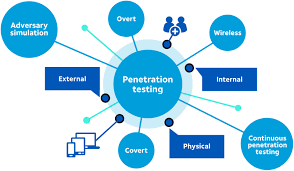Penetration Testing: The Key to Cybersecurity Preparedness
In today’s interconnected digital world, businesses face unprecedented cybersecurity challenges. The rise in cyberattacks has made it critical for organizations to adopt proactive measures to safeguard their assets, data, and reputation. Penetration testing has emerged as a vital strategy to address these challenges effectively. This approach not only identifies vulnerabilities within systems but also empowers organizations to fortify their defenses against potential threats.
Understanding Penetration Testing and Its
Importance
Penetration testing, often referred to as ethical hacking, is a simulated
cyberattack conducted by skilled professionals to assess the security of an
organization’s IT infrastructure. Unlike malicious hackers, penetration testers
operate with the organization’s consent to uncover weaknesses before real
attackers exploit them. This practice involves evaluating various components, including
networks, applications, and endpoints, to identify potential entry points for
cyber threats.
The significance of penetration testing lies in its ability to provide a
comprehensive understanding of an organization’s security posture. It helps in
detecting vulnerabilities that may arise due to misconfigurations, outdated
software, or weak access controls. By addressing these weaknesses,
organizations can reduce the likelihood of data breaches, financial losses, and
reputational damage.
The Process of Penetration Testing
A well-executed penetration test follows a structured process that includes
planning, execution, and reporting. The first phase involves defining the scope
and objectives of the test, which ensures that the assessment aligns with the
organization’s security goals. Penetration testers work closely with
stakeholders to determine the systems and applications to be tested and the
methods to be employed.
During the execution phase, testers employ various techniques to simulate
real-world attack scenarios. These techniques may include reconnaissance,
vulnerability scanning, and exploitation. The goal is to mimic the tactics used
by malicious actors to identify potential security gaps. Advanced tools and
methodologies, such as social engineering and zero-day exploit testing, may
also be employed to uncover hidden vulnerabilities.
The final phase involves documenting the findings and providing actionable
recommendations. The penetration testing report highlights the vulnerabilities
discovered, their potential impact, and prioritized remediation steps. This
report serves as a roadmap for strengthening the organization’s security
measures and achieving long-term resilience.
Benefits of Proactive Penetration Testing
Proactive penetration testing offers numerous advantages to organizations
seeking to enhance their cybersecurity defenses. One of the primary benefits is
the ability to identify and address vulnerabilities before they can be
exploited by cybercriminals. This preemptive approach reduces the risk of data
breaches and ensures compliance with industry regulations and standards.
Moreover, penetration testing provides organizations with valuable insights
into their security strengths and weaknesses. By understanding their
vulnerabilities, businesses can make informed decisions about resource
allocation and invest in targeted security measures. This proactive strategy
minimizes downtime, protects sensitive information, and fosters customer trust.
Another significant advantage of penetration testing is its role in
improving incident response capabilities. By simulating real-world attack
scenarios, organizations can test their detection and response mechanisms,
enabling them to identify gaps and refine their processes. This preparedness
ensures a swift and effective response to actual cyber threats, minimizing
potential damage.
Challenges in Penetration Testing and How to
Overcome Them
While penetration testing is a powerful tool for threat elimination, it is
not without challenges. One common challenge is the complexity of modern IT
environments. The proliferation of cloud computing, IoT devices, and remote
work has expanded the attack surface, making it difficult to identify all
potential vulnerabilities. To address this, organizations should collaborate
with experienced penetration testing providers who possess expertise in diverse
technologies and environments.
Another challenge is ensuring that the findings of penetration tests are
actionable and effectively implemented. Organizations may struggle to
prioritize remediation efforts due to resource constraints or lack of
expertise. To overcome this, it is essential to involve key stakeholders,
including IT and management teams, in the decision-making process. Clear
communication and collaboration between these teams can streamline remediation
efforts and enhance overall security.
Choosing the Right Penetration Testing Provider
Selecting a reliable penetration testing provider is critical to the success
of the initiative. Organizations should evaluate providers based on their
experience, certifications, and methodologies. It is important to choose a
provider that aligns with the organization’s industry, size, and specific
security needs. Additionally, the provider’s ability to deliver detailed and
actionable reports is a key factor in ensuring the effectiveness of the testing
process.
Reputable penetration testing providers, such as Plutosec, offer tailored
solutions to address the unique security challenges faced by organizations.
With a team of skilled ethical hackers and a commitment to excellence, Plutosec
empowers businesses to proactively identify and eliminate threats, ensuring
robust cybersecurity defenses.
Conclusion
Proactive penetration
testing is an indispensable component of a comprehensive cybersecurity
strategy. By simulating real-world attack scenarios, organizations can identify
and address vulnerabilities before they are exploited by malicious actors. This
approach not only enhances security but also fosters trust and confidence among
customers and stakeholders. Choosing a reliable penetration testing provider,
such as Plutosec, ensures that organizations receive expert guidance and
tailored solutions to meet their unique security needs. In an era where cyber
threats are constantly evolving, penetration testing remains a critical tool
for safeguarding digital assets and achieving long-term resilience.

.jpeg)

.jpeg)
Comments
Post a Comment